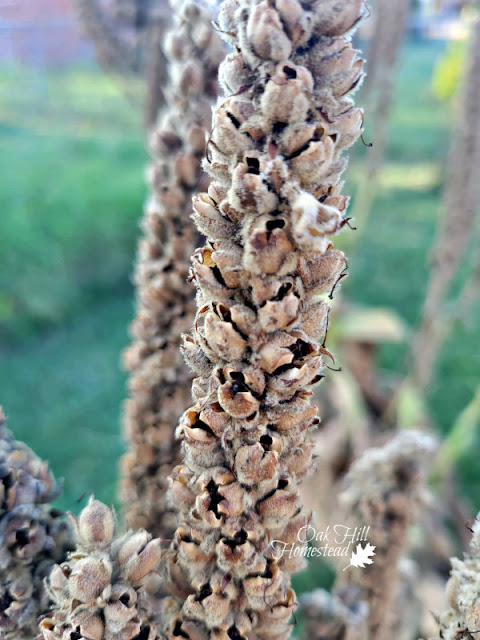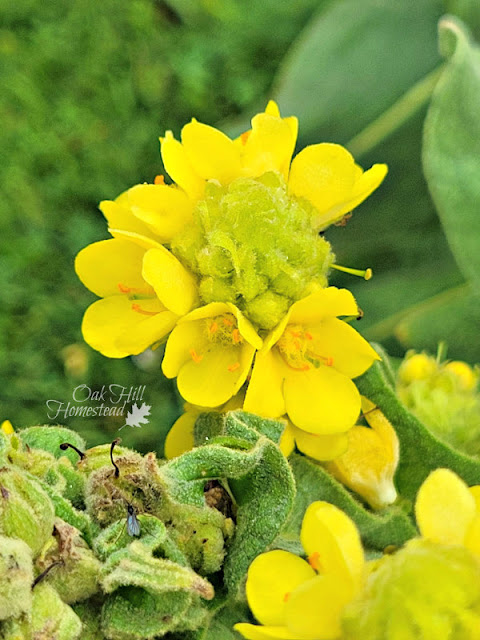Woolly mullein is considered a common weed by most people, but this fuzzy leaf plant has been used for centuries for its medicinal properties.
The easy-to-identify woolly mullein plant is a versatile and powerful addition to any natural medicine cabinet. In this post, we'll show you how to identify woolly mullein, forage it, dry the leaves and flowers for use in teas and tinctures, save the seeds, and even plant them in your own garden. With our tips and tricks, you'll be a wooly mullein expert in no time!
"A weed is simply a plant that you don't know what to do with."
Author Unknown
How to identify and use woolly mullein
I love that so many herbs grow wild here on our land. Even though they're not all growing close at hand in my yard, I know where they are and that they are available when I need them.
Mullein is one of the easiest wild herbs to identify. You've probably noticed it growing along a country roadside, even if you didn't know what it was.
This post was updated in July 2024.
What is Woolly Mullein
Woolly mullein (or "wooly" - it's spelled both ways) is also known as common mullein, great mullein, flannel mullein, velvet dock, flannel leaf, witch's taper, candlestick and other names. Its scientific name is verbascum thapsus.
There are other varieties of mullein as well, but in this post we are discussing woolly mullein/common mullein.
Mullein grows in "disturbed places" such as roadsides, ditches, fields and abandoned areas.
We have a mullein patch growing in the far corner of the horses' winter pasture, and another large patch in a cattle pasture down the road from us where some bulldozer work was done a few years ago.
Those flower spikes down the road are easily visible from our dirt road and I sometimes stop the car to watch the bees busily working the flowers.
How to identify woolly mullein
Mullein is a biennial plant, taking two years to complete its growing cycle and produce seeds.
Woolly mullein's large, fuzzy, sage-green leaves grow low to the ground the first year and are recognizable by their size and texture. Its leaves are covered in fine white hairs that give them a woolly appearance.
In the second year the plant sends up a tall flowering spike that can reach six feet or more in height.
Even if you couldn't identify mullein in its first year of growth, you won't be able to miss it during its second year when it sends up its flower spike with little yellow flowers.
Found throughout the United States in zones 3-9, woolly mullein prefers partial sun and dry soil, and will continue to grow and thrive through drought years.
Why you might want to plant some mullein of your own
Mullein is worth growing in your garden for the texture of the leaves and the striking flower stalks. The flowers attract bees and other beneficial insects.
And wouldn't your child or grandchild enjoy stroking the soft fuzzy leaves? Nurturing a relationship between children and plants is time well spent.
Keep reading for growing and transplanting directions and tips.
Uses for woolly mullein
Besides being soft and fuzzy and pretty, mullein is also a very useful herb.
Mullein tea is used to treat respiratory problems and lung diseases. The dried eaves can be smoked to relieve lung issues.
Salve and ointment made from mullein leaves is used to soothe and heal burns, rashes and more.
The tiny hairs that make the leaves soft and fuzzy can be irritating though, so strain and filter mullein tea, tinctures and infusions carefully to remove the hairs.
Mullein tea and tinctures
Mullein tea is excellent for coughs and colds, bronchitis and other respiratory issues. The leaves contain an immunosuppressant that can soothe mucous membranes.
Mullein leaf tea also soothes irritated skin and sore throats. To use on rashes and irritated skin, use the cooled tea as a wash.
To make mullein tea, add a teaspoon of dried mullein leaves to a mug and add one cup of hot water. Let the tea steep for about 30 minutes, then strain out the plant material.
Add honey to mullein tea to make cough syrup.
Mullein can also be tinctured and taken to treat coughs and other respiratory issues.
Learn how to make a tincture for allergy season using woolly mullein and marsh mallow in this video from Healing Harvest Homestead, or read about it here.
This tincture has made such a difference in my life since I developed seasonal allergies a few years ago!
Mullein flowers
Second-year plants are also useful though. The tiny yellow flowers on the flower spikes provide a soothing and cleansing effect for skin problems.
An easy treatment for minor wounds and scrapes is to make mullein tea with the little yellow flowers instead of dried leaves, and use it as a wash on the affected area.
Mullein flowers can also be infused in oil and used as a very effective treatment for ear infections.
You can combine that mullein flower-infused oil with some beeswax to make a mild but effective ointment that prevents and treats diaper rash.
You'll find directions for infusing plants in olive oil here. The oil is made the same way whether you plan to use it in soap making, make a salve or ointment, or use it to treat an ear infection.
Foraging mullein leaves and flowers
Because the flowers are tiny and they open over a period of time - not all at once - it's necessary to either harvest from a large patch or to pick some open flowers daily.
When making tea and tincures with mullein leaves, many people say that the first year leaves should be used, before they send up that tall flower spike.
Don't forage woolly mullein that is growing alongside a road, as they can be contaminated by exhaust fumes from cars.
Harvesting woolly mullein
Follow these tips when harvesting mullein:
- You may want to wear gloves when harvesting mullein leaves, since those tiny hairs can irritate your skin.
- The leaves will ooze a thick liquid when they're cut, so take a bag along to carry your leaves back home in.
- Harvest only the freshest and cleanest leaves.
- Older leaves that are yellow, brown or dry should be left behind.
- Pick or cut the leaves from the plant, after the dew has dried.
- Pick the flowers by hand from the flower stalk.
Please harvest responsibly. Don't strip a patch bare by taking all of the plants or flowers.
Leave enough leaves so the plant can continue growing, and leave enough flowers to provide for pollinators and so there will be seeds for the next generation of plants.
Drying mullein leaves and flowers
Mullein leaves can be air-dried on a screen for several days. Because the leaves can be quite large and thick, you can cut or tear them into smaller pieces for faster drying. Cut out the large vein in the middle of the leaf, then cut the leaf into sections.
The flowers can also be air dried on a screen.
Store the leaves and the flowers in a cool, dry place out of direct sunlight. When the color begins to fade, their medicinal properties have also begun to fade.
Mullein leaves can also be frozen whole in freezer bags, for use in poultices.
Can you transplant woolly mullein to your garden?
Adult mullein plants are hard to transplant due to the very long taproot, but in spring you can usually find seedlings near the brown stalks of last year's plants. I've successfully transplanted these small seedlings because the tap root isn't long yet.
Mullein is a biennial plant, which means that its life span is two years. In the second year, the plant sends up a tall flower spike and then produces seeds. Transplanting a mullein plant in its second year is very difficult. It's better to leave it where it is and harvest leaves, flowers and seeds from its original location.
You can also gather the tiny seeds from the mature flower stalks in the fall. Allow the flowers to mature and dry, then gather the seeds. The seeds should be kept in a cool, dry place.
Mullein seeds prefer to be cold-stratified. It's best to sow the seeds directly in the fall where you want them to grow. Sow them on the surface of the soil and press them in lightly. Mullein needs light to germinate so don't plant them too deeply. They will germinate and grow in the spring.
 |
| Each of those little yellow flowers on a mullein stalk leaves a brown capsule where the seeds mature. Every one of the holes in this photo is filled with tiny black seeds. |
Or you can refrigerate the seeds for 4-6 weeks, then start them indoors about six weeks before your last frost date. Again, sow them on the surface of the soil, not too deeply. They should germinate in about 12-15 days. Transplant the seedlings to the garden after all danger of frost.
A mature woolly mullein plant can take up quite a bit of space, so plant them where they won't be crowded. Mullein leaves are usually 5-12 inches in length, so the plants will need about 4 square feet of space.
Woolly mullein can indicate soil health
Have you ever noticed a mullein flower stalk that is twisted, forked or crooked? The flower stalks indicate the contamination level of the soil.
A straight stalk indicates clean soil. If the stalks are anything other than straight and healthy, the soil is contaminated.
Mullein in folklore and legends
Woolly mullein has a long history of use in folklore and legends.
In ancient times, the dried plant spike was often used as a torch, giving the plant the nicknames hags taper and torch plant.
In medieval Europe, mullein was thought to protect against the plague, perhaps because it's so useful in supporting and treating the lungs.
Mullein plant was also used in Native American folklore as a natural remedy for a variety of ailments including abscesses, bruises, sprains, rashes, and burns. [Source]
In conclusion
Woolly mullein is a fascinating plant, with many uses, benefits, and a rich history.
Whether you're a seasoned forager or are new to the world of wildcrafting, woolly mullein is a great plant to get to know. Remember to always be respectful and to only take what you need.
NOTE: I am not a medical doctor. Before using this or any herb, please research it fully. You are responsible for your own health.
Facebook | Pinterest | Instagram | Subscribe






















